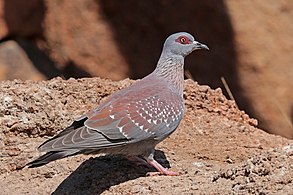Speckled pigeon
| Speckled pigeon | |
|---|---|

| |
| Table Mountain, Cape Town, South Africa | |
| Scientific classification | |
| Domain: | Eukaryota |
| Kingdom: | Animalia |
| Phylum: | Chordata |
| Class: | Aves |
| Order: | Columbiformes |
| Family: | Columbidae |
| Genus: | Columba |
| Species: | C. guinea
|
| Binomial name | |
| Columba guinea | |
The speckled pigeon (Columba guinea), also African rock pigeon or Guinea pigeon, is a
Taxonomy
In 1747 the English naturalist
There are two recognised subspecies:[4]
- C. g. guinea Linnaeus, 1758 – Mauritania to Ethiopia south to the Democratic Republic of the Congo and northern Malawi
- C. g. phaeonota Gray, G.R., 1856 – southwestern Angola to Zimbabwe and South Africa
Description
This is a large pigeon at 41 cm in length. Its back and wings are rufous, the latter heavily speckled with white spots. The rest of the upperparts and underparts are blue-grey, and the head is grey with red patches around the eye. The neck is brownish, streaked with white, and the legs are red. Sexes are similar, but immatures are browner than adults and lack the red eye patches. The call is a loud doo-doo-doo.
Behaviour and ecology
The speckled pigeon is frequently seen around human habitation and cultivation. Most of its food is vegetable, and it gathers in large numbers where grain or groundnuts are available. This species builds a large stick nest on protected rocky outcrops and in urban areas often atop covered pergola pillars and on flat roofs under deep eaves and lays two white
-
C. g. guinea, Lake Baringo, Kenya
-
C. g. bradfieldi, Damaraland, Namibia
-
C. g. phaeonota with chick in nest, Cape Town, South Africa.
-
Eggs, Collection Museum Wiesbaden
References
- . Retrieved 13 November 2021.
- ^ Edwards, George (1747). A Natural History of Uncommon Birds. Vol. Part II. London: Printed for the author, at the College of Physicians. p. 75.
- ^ Linnaeus, Carl (1758). Systema Naturae per regna tria naturae, secundum classes, ordines, genera, species, cum characteribus, differentiis, synonymis, locis (in Latin). Vol. 1 (10th ed.). Holmiae:Laurentii Salvii. p. 163.
- Rasmussen, Pamela, eds. (July 2021). "Pigeons". IOC World Bird List Version 11.2. International Ornithologists' Union. Retrieved 9 October 2021.
- Birds of the Gambia by Barlow, Wacher and Disley, ISBN 1-873403-32-1
External links
- (Rock Pigeon = ) Speckled Pigeon - Species text in The Atlas of Southern African Birds.
- Speckled Pigeon: Breed Guide - Pigeonpedia





